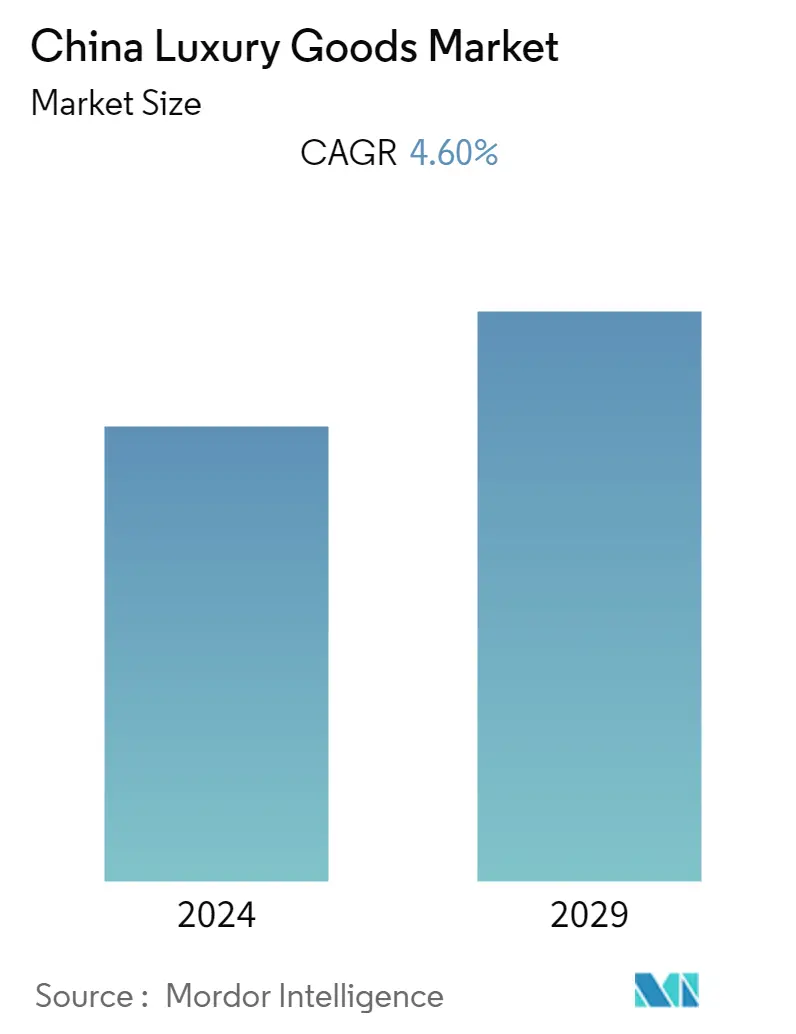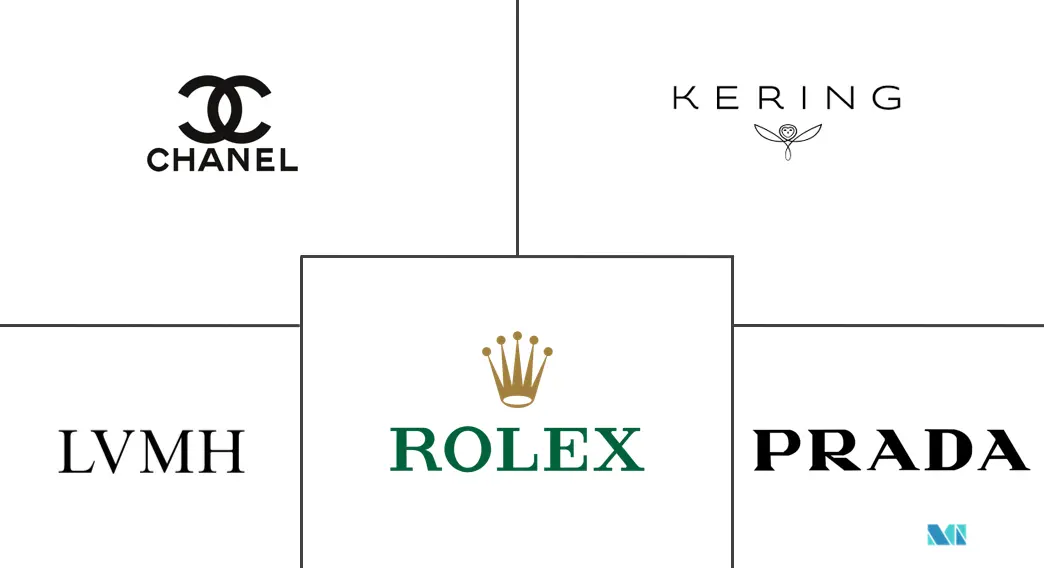Market Size of China Luxury Goods Industry

| Study Period | 2019 - 2029 |
| Base Year For Estimation | 2023 |
| Forecast Data Period | 2024 - 2029 |
| Historical Data Period | 2019 - 2022 |
| CAGR | 4.60 % |
| Market Concentration | Low |
Major Players
*Disclaimer: Major Players sorted in no particular order |
China Luxury Goods Market Analysis
The China luxury goods market is projected to register a CAGR of 4.6% during the forecast period (2022-2027).
The first and second waves of the COVID-19 pandemic have negatively affected China's fashion industry as factories, stores, and public events were strictly banned to prevent the spread of the coronavirus. For instance, the pandemic caused the cancellation of the Beijing and Shanghai Fashion Weeks, scheduled between March 25th and 31st, 2020, which ultimately affected the brand communication with prospective customers.
Over the medium term spending in China's market is expected to boom owing to the solid consumer confidence and willingness to buy luxury items supported by the economic development. The trend is prevalent, especially among young generations. For instance, the consumer study published in 2020, in the international journal of market research shows that around 13% of respondents favor cosmetics and shoes as luxury purchases in China.
Over the long term, the increase in disposable income, urbanization, and digitalization are the main factors anticipated to drive the growth of the luxury goods market in China.
China Luxury Goods Industry Segmentation
Luxury goods are not essential products but are deemed highly desirable within a culture or society. The China luxury goods market is segmented by type and distribution channel. By type, the market is categorized into clothing and apparel, footwear, bags, jewelry, watches, and other types. By distribution channel, the market is categorized into single-brand stores, multi-brand stores, online retail stores, and other distribution channels. The report offers market sizing and forecasts in terms of value (in USD million) for all the above segments.
| By Type | |
| Clothing and Apparel | |
| Footwear | |
| Bags | |
| Jewelry | |
| Watches | |
| Other Types |
| By Distibution Channel | |
| Single-brand Stores | |
| Multi-brand Stores | |
| Online Stores | |
| Other Distribution Channels |
China Luxury Goods Market Size Summary
The China luxury goods market is experiencing a resurgence, driven by robust consumer confidence and a growing appetite for luxury items, particularly among younger generations. Despite the initial setbacks caused by the COVID-19 pandemic, which disrupted fashion events and brand communications, the market is poised for growth. Key factors such as increasing disposable income, urbanization, and digitalization are expected to propel the market forward. The shift towards online shopping is significant, with digital channels playing a crucial role in influencing consumer purchases. Brands are adapting by enhancing their digital marketing and online retail strategies, partnering with major e-commerce platforms to reach a broader audience.
The market landscape is characterized by a mix of international and local players, with prominent companies like LVMH, Chanel, Cartier, Rolex, and Kering leading the charge. These brands are diversifying their product offerings and expanding their distribution networks to capture the burgeoning luxury consumer base in China. Innovations such as pop-up stores and collaborations with e-commerce giants like JD.com are helping brands maintain a competitive edge. Additionally, offshore duty-free shops have emerged as a significant sales channel, offering attractive pricing and expanded product categories, further boosting luxury goods sales in the region.
China Luxury Goods Market Size - Table of Contents
-
1. MARKET DYNAMICS
-
1.1 Market Drivers
-
1.2 Market Restraints
-
1.3 Porter's Five Force Analysis
-
1.3.1 Threat of New Entrants
-
1.3.2 Bargaining Power of Buyers/Consumers
-
1.3.3 Bargaining Power of Suppliers
-
1.3.4 Threat of Substitute Products
-
1.3.5 Intensity of Competitive Rivalry
-
-
-
2. MARKET SEGMENTATION
-
2.1 By Type
-
2.1.1 Clothing and Apparel
-
2.1.2 Footwear
-
2.1.3 Bags
-
2.1.4 Jewelry
-
2.1.5 Watches
-
2.1.6 Other Types
-
-
2.2 By Distibution Channel
-
2.2.1 Single-brand Stores
-
2.2.2 Multi-brand Stores
-
2.2.3 Online Stores
-
2.2.4 Other Distribution Channels
-
-
China Luxury Goods Market Size FAQs
What is the current China Luxury Goods Market size?
The China Luxury Goods Market is projected to register a CAGR of 4.60% during the forecast period (2024-2029)
Who are the key players in China Luxury Goods Market?
Prada SPA, Chanel SA, LVMH Moët Hennessy Louis Vuitton, Kering SA and Rolex SA are the major companies operating in the China Luxury Goods Market.

